The Deep Sea Dilemma
TO MINE OR NOT TO MINE?
July 21st, 2023
Written by: Gabriela Ramirez & Tina Lee
Illustrations by: Juan Carlos Hernández
Multimedia: Gabriela Ramírez
Proponents say that mining the deep seas will provide a nearly unlimited resource of valuable metals, solving the problem of where to get the materials needed for the green energy transition, with the profits shared by all mankind. However, the pressing question remains: Can we justify the costs? Part 1 of the Unbias the News’ investigation into Deep Sea Mining.
100 years from now, will we look back on the summer of 2023 as the turning point for our oceans?
From the viewpoint of this moment in July, the ocean, the vast repository of water that predates all life on earth, is a major feature in all man-made religions and myths, and plays a central role in balancing the global ecosystem is suddenly “hot” for several reasons.
In June, the deep ocean was front and center in the news after a company promising luxury tours to the sunken Titanic ship carried several wealthy men to a tragic end as the world watched breathlessly (and in some cases, with an ample dose of schadenfreude). In the months before, a number of apparently coordinated attacks by orca whales on yachts owned by the ultra-wealthy likewise made headlines and spawned snarky memes all over the world. And already in spring, scientists sounded the alarm of record-shattering high oceanic temperatures, leading to concerns for marine life and heralding the return of yet another unwelcome 90’s trend, El Niño. The continuing bathtub-warm temperatures of beaches have provided no respite from the scorching land.
All in all, mid-summer 2023 is a moment in time when the ocean seems more dangerous, vengeful and mysterious than ever. Which makes the ongoing events in Kingston, Jamaica all the more appropriate. For any day now, a group representing most of the world’s governments will decide upon the future of the ocean in a critical way: can we mine the deepest stretches of the world’s oceans for metals needed for the green energy transition?
The question is so significant that it has brought out apocalyptic pronouncements on both sides: people in favor of deep sea mining say it’s the best (and maybe only) way to save the world from climate change in time. Scientists and activists however warn it could set off a chain reaction that could destroy entire ecosystems. Meanwhile, local communities in places like Hawaii, located about 800 km from the potential mining zone (the Clarion-Clipperton Zone or CCZ), stress the profound cultural and spiritual importance they attribute to the ocean as the cradle of life itself.
No matter what you are inclined to believe, you are probably working from incomplete information, as we were when we started investigating this fascinating and complicated question. But after months of parsing scientific, economic and industry reports and speaking to people who study the oceans, campaigners who work to protect it, and yes, business entrepreneurs who want to explore it and harvest its treasures, we have been able to dive much deeper into this topic, and hopefully help readers understand what is at stake so they can make up their own minds. Read on, and stay tuned for several upcoming articles exploring different aspects of the rush to mine the world’s oceans in our project “Sleepwalking into the Deep Sea.”
The hunt for buried treasure has revealed an ocean even stranger and more mysterious than we thought.
THE COMMON HERITAGE OF (HU)MANKIND
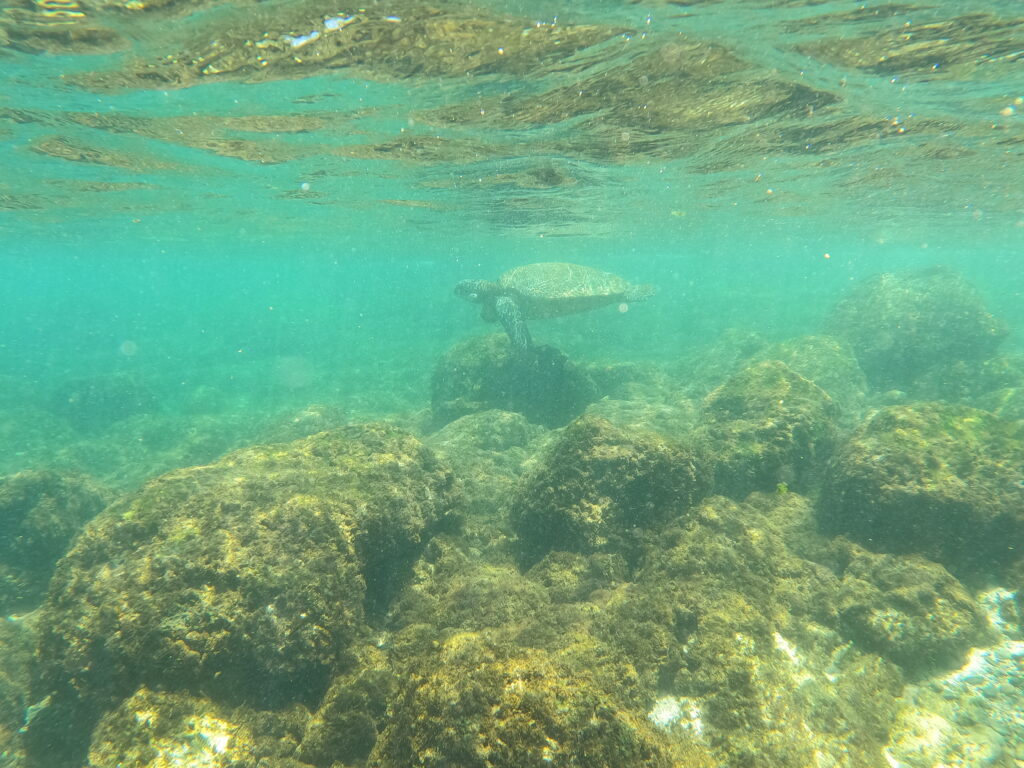
To understand what is happening in Jamaica, we have to go back decades, to the signing of the UN Convention on the Law of the Sea (UNCLOS).
At nearly 200 pages, the 1982 treaty is a massive international agreement formalizing the customary laws that had governed how countries interacted with the ocean for hundreds of years, and deals with the critical question of where a nation’s sovereign borders end and the communal “deep sea” begins.
Nearly a century before state representatives gathered to address these questions, there was already knowledge of potentially vast stores of metals and minerals on the seabed, and the question of who could exploit this territory in the future was a provocative topic during the rush for global resource dominance during the Cold War.
The exploitation of these resources “could mark the beginning of the end for man, and indeed for life as we know it. It could also be a unique opportunity to lay solid foundations for a peaceful and increasingly prosperous future for all peoples,” the Maltese diplomat Arvid Pardo said in 1967 during a three-hour speech to the United Nations Assembly in its 22nd Session.
Not everything Pardo said remains so prescient. For instance, he believed that in the future, deep sea farming could potentially replace land agriculture, with dolphins used as “sheep dogs” and “air-bubble curtains” to protect fish cattle-ranges. However, he did end up coining the powerful phrase that runs throughout the UNCLOS that defines the deep seas as the “common heritage of mankind,” as opposed to the property of whoever is the fastest to reach it.
“The known resources of the sea-bed and of the ocean floor are far greater than the resources known to exist on dry land. The sea-bed and the ocean floor are also of vital and increasing strategic importance. Present and clearly foreseeable technology also permits their effective exploitation for military or economic purposes. Some countries may therefore be tempted to use their technical competence to achieve near-unbreakable world dominance through predominant control over the sea-bed and the ocean floor.”
Arvid Pardo, 1967
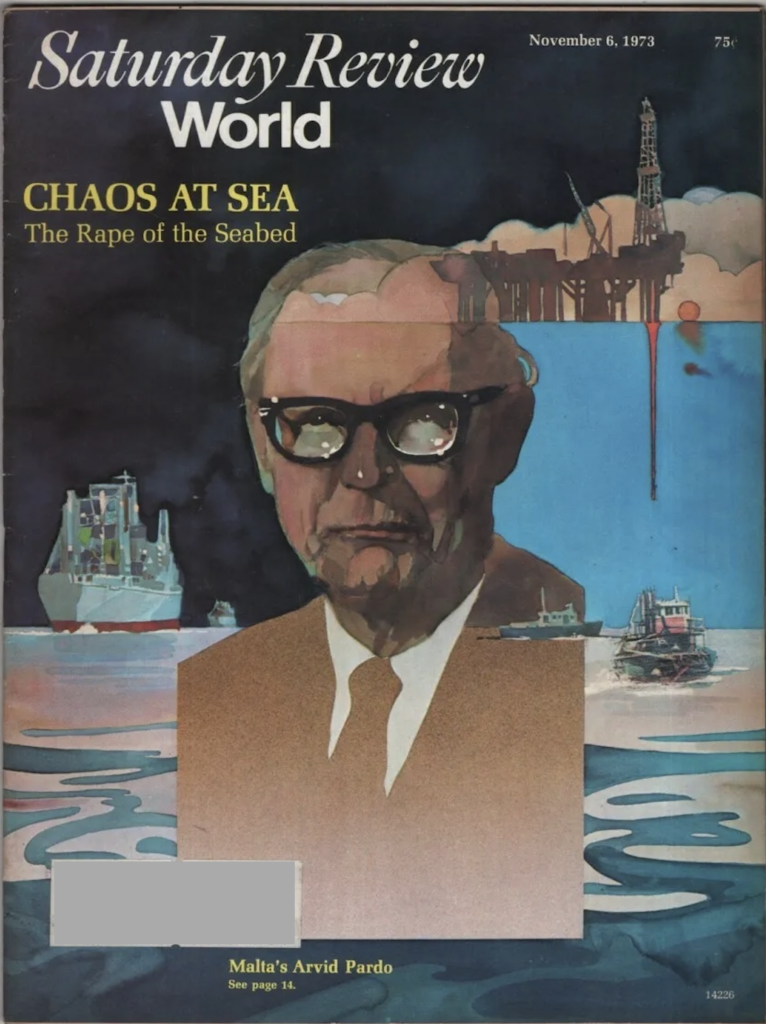
Three years later, Pardo’s popular speech played a pivotal role in the establishment of the oceans’ governing treaty. Among other things, the UNCLOS envisioned the creation of a new UN body to govern the future mining of the deep sea, a little-known agency established years later called the International Seabed Authority (ISA).
IT ALL COMES DOWN TO KINGSTON
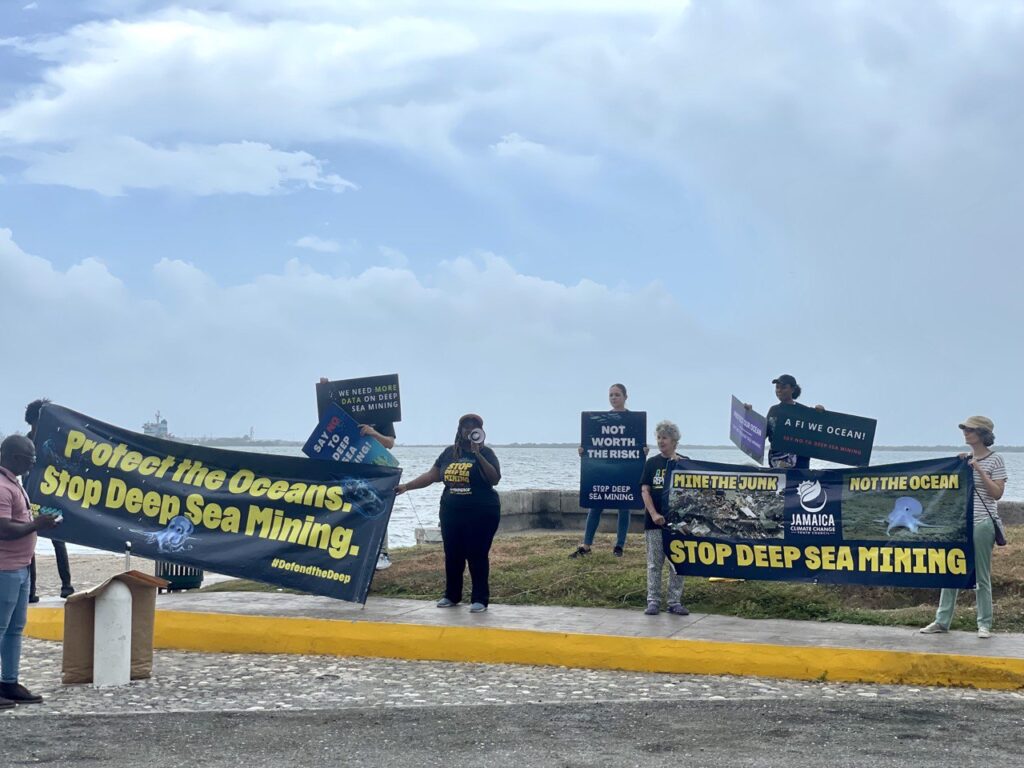
Local activists in Kingston protest in front of Jamaica Conference Center while leaders are meeting discussing negotioations on Deep Sea Mining.
From July 10th until the 28th during this hottest summer on record, Pardo’s ideas are being discussed and redefined at the 28th Session, the latest gathering of the ISA at its headquarters in Kingston, Jamaica. However, discussions on negotiations about our “common heritage” are far from inclusive to all of us.
Meetings are held in some cases out of sight, with multiple live-stream shutdowns where delegates meet behind closed doors and media not allowed in the main room, after only being credited for one week out of the three-week long meeting.
In fact, besides our Unbias The News reporter, there are only two more journalists in the room at the ISA, a little-known UN body roundly criticized due to a lack of transparency and an unseemly coziness with business interests in handling the negotiations for deep sea mining.
Since its establishment in 1994, the ISA has been tasked with preparing for the future of deep sea mining by issuing contracts for exploration and developing the regulations that will govern how mining is to eventually take place. While the ISA has issued over 30 contracts for exploration, the pace for creating rules has been slow, a fact that scientists say is due to the many unanswered questions that remain about the ecosystem of the deep ocean. The regulations have been in development since 2014, but further work was paused during the pandemic.
In 2021, the island state of Nauru, a country roughly the size of Manhattan, significantly fast-tracked the pace of development when they triggered an obscure provision of UNCLOS that stated a country could demand the rules be finished within two years of asking for it, a provision known as the “two year rule.”
If the members of the ISA agree to honor the two year rule, then commercial mining operations could start as soon as 2024 - and mining contracts would have to be considered whether regulations were completed or not.
Commercial mining companies are banking on the appeal of what they say deep sea mining offers: A nearly limitless source of the minerals needed for powering the green energy transition and a net-zero economy, harvested from the ocean by technologically advanced vessels, with the profits shared by all mankind. All this with a lighter environmental and human impact than land mining.
However, could such a framework to regulate mining operations over 4.000 meters depths, involving ambitious companies and geopolitically-averse countries in a race to profit from the resources supposed to benefit humankind, be developed on such short notice? The history of similar international treaties tells us that it might not be possible.
Experts fear that a lack of scientific knowledge about the potential impact of deep sea mining on the oceans will push us to “sleepwalk into seabed mining”. Multiple countries and companies have already called to pause or even ban deep sea mining until the environmental, social and economic risks are better understood and other alternatives to deep-sea minerals have been explored.
Ultimately, Nauru has forced the question: Are we ready to mine the deep sea? In order to answer this, we need to understand the demand for what lies at the bottom of the ocean, and be able to address perhaps the biggest unanswered question: how can we protect something we don’t fully understand?
A BATTERY IN A ROCK?
The transition away from fossil fuels requires a complete revolution in how we power our society. This revolution may need to take place faster than most people realize: reports after the issuing of the latest report of the Intergovernmental Panel of Climate Change (IPCC) showed that governments negotiated to remove a key sentence from the summary that stated the stakes as clearly as possible: we have 12 years to reduce carbon emissions by two thirds. Instead, that conclusion was hidden in the data of the lengthy report.
Stated openly or not, the race is on to find substitute power sources to shift away from fossil fuels, from wind to solar to thermal and those yet to be discovered. But underlying all these solutions lies a need for minerals and metals that are currently extracted from land in mining operations scattered across the earth’s surface, from the Atacama desert of Chile to tropical forests in Indonesia. The metals will be used to power batteries and motors, and store energy gained from sustainable resources other than fossil fuels.
Underlying the rationale for Deep Sea Mining is the tantalizing glimpses of what we know lies at the bottom of the ocean because of extensive (and expensive) research undertaken by scientists, governments and entrepreneurs who have been analyzing the seabed for half a century. Already when Arvid Pardo was addressing the UN, knowledge of “astounding” reserves of metals in the seabed were known, and far more has been discovered in subsequent years.
Metals can be found throughout the vast expanses of our oceans, but it is the Clarion-Clipperton Zone (CCZ) in the central equatorial Pacific that garners the greatest interest due to its exceptional potential for metal reserves. Encompassing approximately 4 million square kilometers, this area stands as the largest known deposit of these resources worldwide.
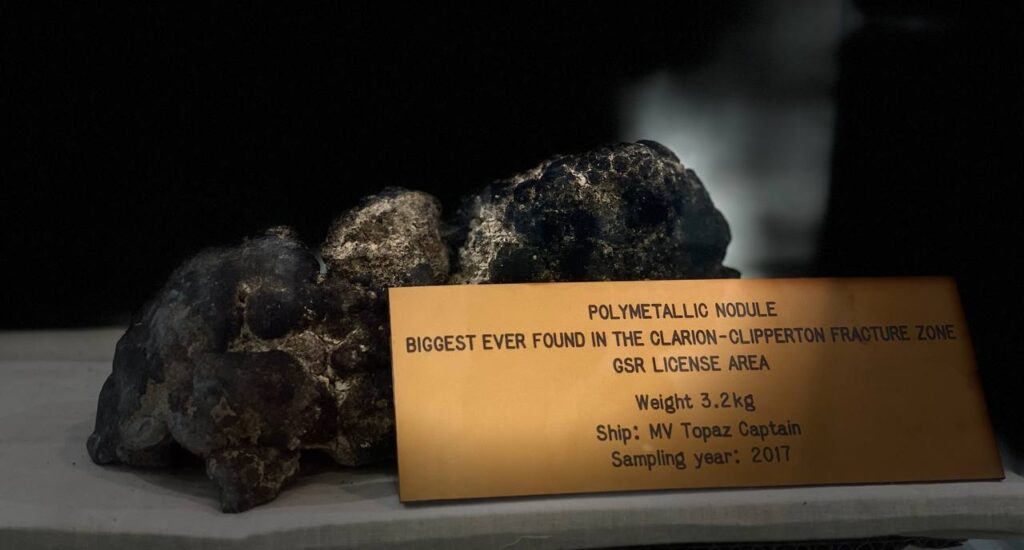
Polymetallic nodule on ISA Museum exhibition in his headquarters in Kingston, Jamaica.
The types of metals eyed by mining companies fall into three categories, at different ocean depths. On the sides of undersea slopes at a relatively shallow depth of 800 to 2,000 meters are cobalt-rich crusts, containing metals such as (obviously) cobalt, but also nickel and manganese. Further down, encrusting the hydrothermal vents that release steam from within the earth’s core are seafloor massive sulfides, which can contain copper, gold and zinc. And resting at the deepest depths of the ocean, 4,000-6,000 meters below the surface in the cheerily-named “abyssal zone” where no sunlight is able to penetrate, are so-called polymetallic nodules, small rocks nestling a mixture of metals that economic experts predict will be critical for the green transition: nickel, manganese, copper, cobalt, and in some cases, traces of valuable rare earth metals like lithium and platinum.
The potato-sized polymetallic nodules, with their convenient metal mixture and terrific distance from the surface, are the hardest to reach and potentially most valuable, what the president of The Metals Company, Gerard Barron, likes to call a “battery in a rock.”
It is fairly indisputable that batteries and fuel cells for renewable technology will likely require metals like cobalt, nickel, manganese, and copper. But how much, and is the demand enough to require the extreme lengths companies and countries must go to in order to mine the depths of our oceans? This is where it gets tricky.
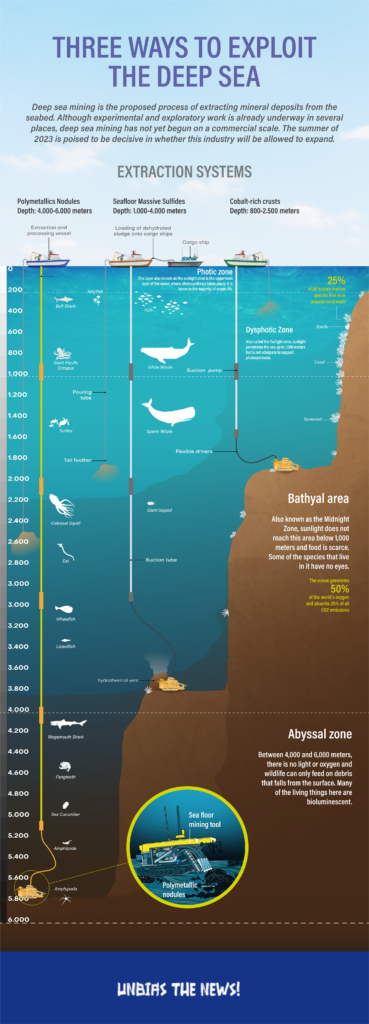
FINDING HIDDEN GEMS
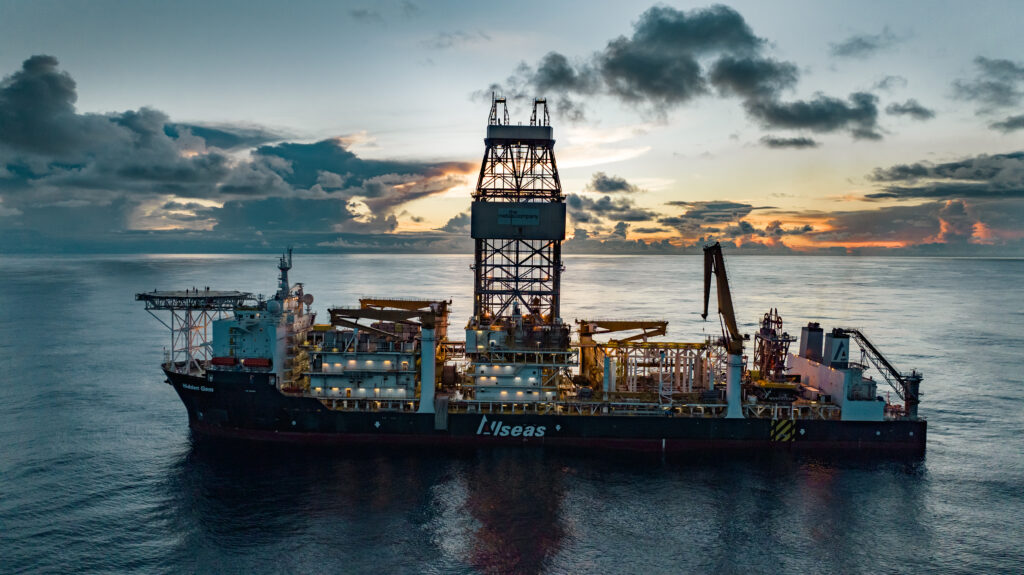
“The Hidden Gem” vessel in the frontline of Deep Sea Mining in the Clarion Cliperton Zone.
Nine pilot tests seeking to recover the same precious metals inside polymetallic nodules have been conducted since the 1970s. 50 years later, their impact is still visible in the area of the seabed they touched. Some scientific studies suggest that changes to the abyssal plain may be as good as permanent on a human time scale. Could that be a warning for us today? Mining companies don’t think so.
“From a technical perspective, we are ready to start mining,” stated a spokesperson from the company overseeing the “Hidden Gem,” a vessel at the forefront of realizing a longstanding ambition in underwater exploitation with about 130 crew members on board carrying out their mission in the middle of the Pacific Ocean. “The whole system that we developed and tested last year in November in the CCZ worked out how we wanted it to.”
The process of how we get these metals today isn’t too different to how it has been done over the past 50 years. “The principles are the same,” said Jeroen Hagelstein, corporate spokesperson from Allseas, a privately owned engineering company hired by The Metals Company as their technology provider.
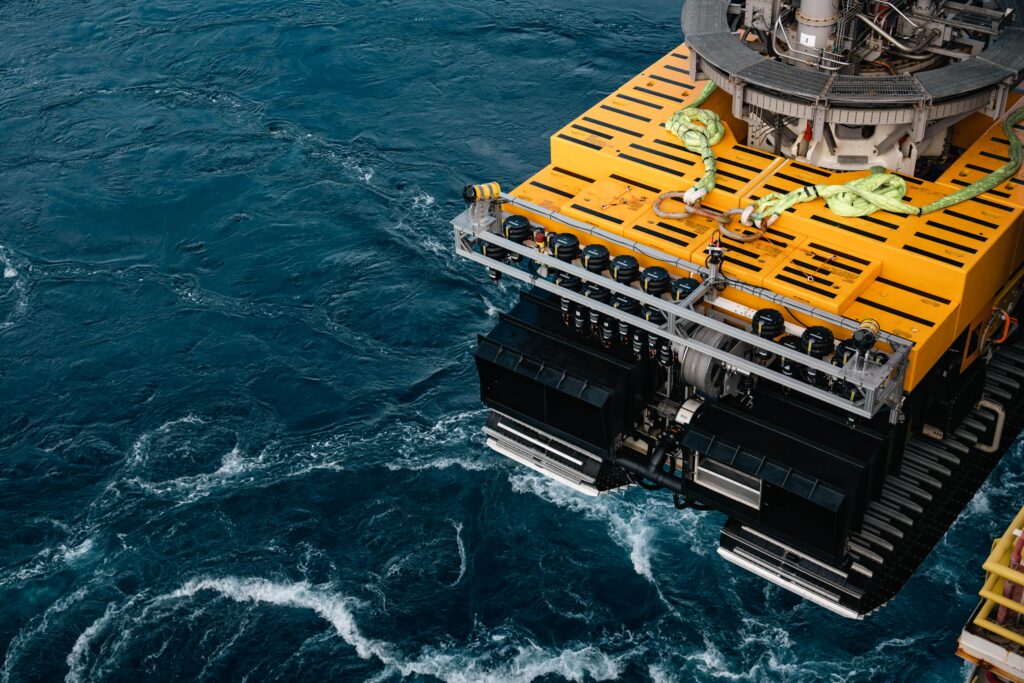
From the “Hidden Gem” vessel a collector is lowered to the seabed. The collector is connected by the flexible jumper hose to the riser, a pipe built piece by piece on the main vessel going vertically down to a depth of over 4.000 meters.
The collector and main vessel will simultaneously start moving forward, the collector driving over the seabed by using tracks, the vessel using its multiple thrusters, vacuuming up loose nodules from the seabed, including stirred-up sediment. The long way up will start from the collector, through the jumper hose back up to the vessel. Up on the vessel the nodules and sediment get separated, with the valuable nodules going to the many holds on the vessel while the worthless sediment is pumped back down thousands of meters where it creates a so-called sediment plume, a cloud of dust, slowly moving through underwater sea currents.
The plumes created by deep sea mining are still being studied to further understand how far these sediments could travel and which could be their impact for mid-water ecosystems. More details on the environmental risks are explained below.
Where these nodules go after collection for further processing is not clear yet. However, some conversations with a Japanese company are ongoing to define a potential collaboration for processing the metals, commented spokesperson from Allseas. Meanwhile, Japanese firm Toyota announced a “breakthrough” that could be a gamechanger to manufacture solid-state batteries as soon as 2027.
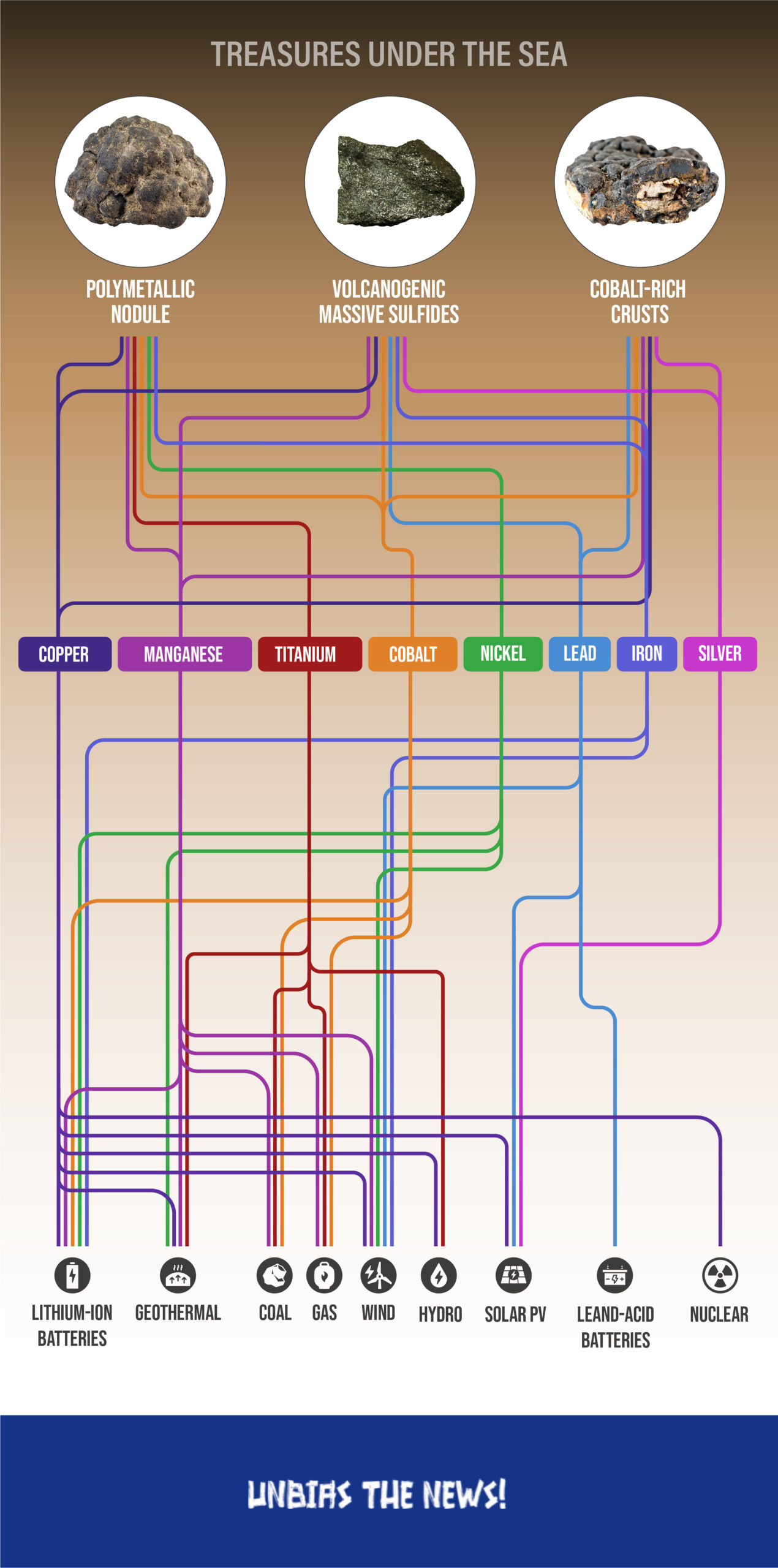
HEAVY METAL DRUMBEAT
Proponents of deep sea mining say that the metals that could be recovered from the seabed in places like the CCZ will be critical for the energy transition. But does the demand for metals for the energy transition really match the metals in the deep sea?
Economic experts offer very different projections for the metals demand that the energy transition will require.
For instance, a spokesperson for The World Bank told Unbias the News that “production of minerals, such as graphite, lithium, and cobalt, could increase by nearly 500% by 2050, to meet the growing demand for clean energy technologies.” But the World Bank’s analysis, and that of other experts like them, hinges on what kind of climate scenario they envision for the future.
According to the Metals Company, the recovery of metals from the CCZ could be enough to power 280 million electric vehicles, equivalent to the entire fleet of cars in the United States. But the idea that the green energy transition depends primarily on the shift to electric vehicles is (another) highly contested one. If every car owner in the USA replaces their personal vehicle with a brand new electric car, will that save the world from the climate crisis? Is that even a desirable development, or will the climate crisis bring about a shift towards shared forms of transportation? Whether you imagine a future full of or free from personal cars makes a big difference in how you calculate demands for metals.
A report on deep sea mining by the European Academies Science Advisory Council (EASAC) similarly found the projections “do not account for policy shifts that reduce dependence on personal vehicles, extensions in product life and reduced obsolescence, or higher recycle rates promoted by regulations.”
According to a recent report by the World Wildlife Fund (WWF), most of the minerals needed for the green transition could actually be supplied by recycled minerals by 2050. The report focuses on seven critical minerals: lithium, cobalt, nickel, manganese, rare earth elements, platinum and copper (note the overlap with the metals available on the sea floor.)
Even this demand can be reduced by up to 58% with recycling, circular economy strategies and technological advancements such as electric vehicle batteries with different chemistries, stationary applications without lithium-ion batteries and electric traction motors and wind turbine generators with low or no rare earth elements, adds the report.
The green transition does not need deep seabed mining to drive a low carbon economy. It is clear that there is a path ahead to decarbonise with a much lesser material footprint.
The Future is Circular - World Wildlife Fund
The decarbonization strategies in the forthcoming decades face significant uncertainty, influenced by a multitude of factors, including pricing dynamics, resource availability, societal and environmental standards, as well as the pace of innovation and technological advancements. The developments of each of these factors over the medium and long term, and their intricate interplay, remain unpredictable.
DEEP TROUBLE? ENVIRONMENTAL RISKS OF DEEP SEA MINING
Despite developments on the surface, the deep ocean remains a place full of wonder and mystery. In fact, most of the waters remain unexplored, uncharted and unseen by human eyes. Merely 5% of this awe-inspiring realm has been meticulously studied and mapped, leaving the vast majority, particularly its profound depths, concealed in a shroud of mystery. What we do know is that it serves an important function for our ecosystem.
The ocean is a huge carbon sink and it's a huge, huge carbon repository and the implications of disturbing very large areas of the seabed are still unclear.
Dr. Michael Norton - EASAC
In their recent report, EASAC reviewed dozens of peer-reviewed scientific studies on the potential environmental risks posed by the processes involved in deep sea mining.
A non-exhaustive list of these risks would include biodiversity loss, permanent destruction of habitats, and pollution by sediment plumes and noise. Talking to experts, we also learned about threats to the human food chain. But known risks are still shadowed by what unknown chain reactions could be set off by disturbing the abyssal deep
Biodiversity loss
Some of the new species found in the deep sea in the Clarion Cliperton Zone. These are in Jeff Drazen’s lab at The University of Hawaii.
The issue of biodiversity loss is sometimes perplexing because many of us are under the impression that there is very little that can live at the bottom of the ocean. While it is true that the ocean floor, because of its complete lack of sunlight, hosts lifeforms different to what we are familiar with on the surface, it is home to an incredible array of strange and wonderful creatures that have evolved to live in this difficult terrain.
“I believe the public should be persuaded to slow down precisely because what is once lost cannot be repaired or replaced. There are undoubtedly many undiscovered species with abilities and functions that we cannot even imagine exists, and we could lose them without knowing they ever existed,” says Dr. Chong Chen, Deep Sea Biologist at Japan Agency for Marine-Earth Science and Technology (JAMSTEC).
Just one example of a creature that makes its home there is the Scaly-foot Snail, a remarkable gastropod living around deep sea vents. Scientists were able to duplicate this snail’s own unique ability to create iron nano-particles in a laboratory, an innovation with potential for use in creating solar panels. That’s just one animal: what talents do other, undiscovered creatures have to share?
“There’s a very real concern of biodiversity loss, and we don’t know what the repercussions of that could be. We do know that in all systems around the world, the function of those systems is dependent upon that biodiversity. Those things are linked. Diversity and the function of the ecosystem”, says Jeffrey Drazen, a professor at the University of Hawaiʻi at Mānoa and scientist collaborating on The Metals Company environmental assessment of Deep Sea Mining.
“The way The Metals Company characterizes the ecology and biodiversity of the Clarion Clipperton zone is very biased,” says Craig Smith, a scientist with over 30 years of experience studying the CCZ.
“They like to make the comparison that the Clarion-Clipperton Zone is low biomass compared to places where terrestrial mining occurs, and so the CCZ is not really worth conserving. But biomass is not the only, or even the most important, criterion in deciding whether or not to conserve an area,” he explains to Unbias The News.
Mining companies have said that the part of the ocean they are aiming to exploit is only about 2% of our global oceans. However, Smith argues that “it’s a little bit silly because one can say that the Amazon rainforest is a small percentage of the terrestrial environment, but that doesn’t mean we shouldn’t protect it.”
Another argument for mining the deep seas is that mining on land is also highly damaging to the terrestrial ecosystem – but continues nonetheless. “By pointing out the damage to the environment caused by deep sea mining, one is not in the same breath justifying the damage to the Congo or to Indonesia in the terrestrial mining there. What one is pointing out, which we did in our report, is that one is much more controllable than the other,” said Dr. Norton.
Like a 24/7 Rock Concert
Aside from direct destruction of habits, there is a concern about the effects that noisy mining operations can have on ocean animals.
“Lots of humans like to go to rock concerts and listen to rock music for an hour and it’s pleasurable. But if they were in that noisy environment 24/7 for months, years, they would go deaf and lose one of their major sensory modalities,” explains the scientist and professor at University of Hawaiʻi at Mānoa, Craig Smith, using a human analogy.
In that sense, “noise pollution from deep sea mining will impact marine mammals and organisms living in the deep ocean” says Smith, who has been an author of multiple independent studies. However, the scientist recognizes that these are very difficult habitats to study but it is expected that they’ll be very sensitive. “We do know that the impacts are likely to be severe, affecting thousands to tens of thousands of square kilometers beyond the direct mining area, even from a single mining operation”, he explains. This comprises designated “no mining zones,” which must remain unaffected by mining activities as mandated by the proposed mining regulations.
Metals in our food?
The little sediments created by the collector driving over the seabed and later sediments discharged back into the sea after the nodules have been collected are a real headache, not only for scientists working on the environmental assessment but also for the seafood industry and probably for you, if you’re a fan of tuna.
“Mining is for metals and some of those may dissolve and may be discharged into the water column. Some of the metals that are the targets of mining and some of those that just come with those metals are toxic to life.”, explains Drazen from his office in the Marine Science Building at the University of Hawaiʻi at Mānoa.
“There is a chance that these kinds of metals may make their way into the food webs that we rely upon for providing us with seafood. I think this is a real concern with the mid-water discharge of these sediment plumes.”, he adds.
Scientist Jeff Drazen explains connections between seafood and potential environmental risks of deep sea mining.
“We’re talking about nodule mining, that could include copper and cobalt and these are toxic metals. Will they also end up in these food webs and end up in our food supply? We don’t know the answer to that question, but that’s an environmental risk that could be really important and that we need to know more about” says Drazen.
BUSINESS RUSH VS DEEP SCIENCE
The exploitation of mineral resources has underpinned the development of modern civilization. But civilization as we know it is not sustainable.
TDI Sustainability and World Economic Forum
Despite all the risks enumerated by scientists who study the ocean ecosystems, the impacts of deep sea mining are “predictable and manageable” according to ISA Secretary, Michael Lodge. Many of the scientists and experts consulted by Unbias The News remain unconvinced. (Requests for interviews with the ISA are still pending as of the 28th Session in Kingston, Jamaica.)
“It’s not predictable. Until it’s predictable, it’s hard to know if it’s fully manageable. If you don’t know what the scales of impacts will be, how do you know you can manage them?” says scientist Craig Smith.
“The consequences of mining the deep-sea are ‘predictable’ in that it would be devastating for the species that live there (most of which we have never seen), but I do not consider this to be ‘manageable’.”
-Dr. Chong Chen
The experts spoken to by Unbias the News are not alone. Over 760 scientists and marine experts from around the world have signed a petition calling for a pause on deep sea mining, saying we simply do not yet have enough information on the deep sea to make a decision on how mining could impact our planet.
With all of the current visible impacts of extractive industries on our planet, what is it that drives some entrepreneurs to push these doubts to the side and rush for chance to mine the ocean? Part of it could be what Jeff Drazen calls “business culture.”
“The business culture has difficulty grasping that you can’t sometimes just throw more money at the problem and make everything go faster. We all want answers for yesterday. We all want the data now. But in the science world, it doesn’t work like that,” comments Drazen, a scientist working on different environmental assessments for The Metals Company, when we met him in his office at the Marine Science building in the University of Hawaii.
“Generating the data and then really fully appreciating it in a reasonable timeframe for the company has been hard for them. That’s been a challenge. So I’m sure they (The Metals Company) complain we are too slow,” adds Drazen.
Precisely the question of timing in deep sea mining could hold answers to many of the questions surrounding the topic. When do we really need these minerals? When can we start mining the ocean? For how long should we mine the ocean? Once it is allowed, when would it be stopped? How long can mining companies wait for regulations without running out of the investments keeping their business afloat?
The reality is that our modern society is faced with some very tough decisions to make.
“Nothing we do as a human society comes without environmental risks. It's that difficult task of answering whether the benefits of achieving these mineral supplies outweigh the environmental risks to the ecosystem and of the services that are provided to us as a society. Carbon sequestration, fishing, seafood, biodiversity. It's a tough choice. And I'm not sure we have all the information we really want to answer that question just yet.” says Drazen.
But in Kingston, Jamaica, the clock is ticking to decide – on the two year rule, the 12 years we have to reduce emissions, the time before demand for metals potentially outweighs supply, the time where major monetary investments expect a return. But most of all, the pressure is on to decide how best to use the unexplored deep that humans decided is our common property for the good of all mankind.
Research for this article was made possible with the support of the Heinrich-Böll-Stiftung Washington, DC.
Stay tuned for the next parts in our series, where we will delve into the business side of deep sea mining, the state of the art in land mining, and the question of how best to protect our oceans.
Read our articles
“
Full fathom five thy father lies;
Of his bones are coral made;
Those are pearls that were his eyes:
Nothing of him that doth fade,
But doth suffer a sea-change
Into something rich and strange.
William Shakespeare, The Tempest

This article is part of our series “Chain reactions – How the green revolution can reshape sustainable development”. The series is funded by the European Journalism Centre, through the Solutions Journalism Accelerator. The Solutions Journalism Accelerator is supported by the Bill & Melinda Gates Foundation.
This project was additionally supported by:









